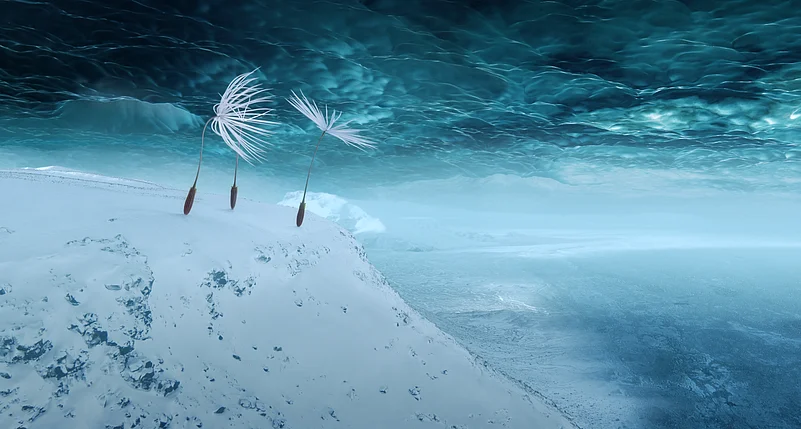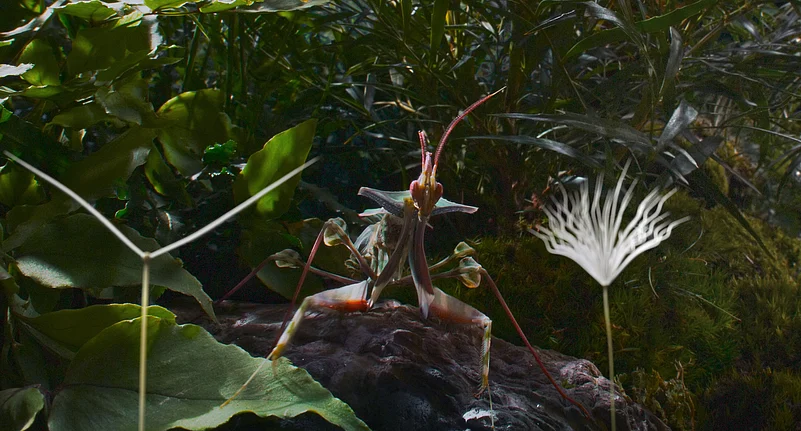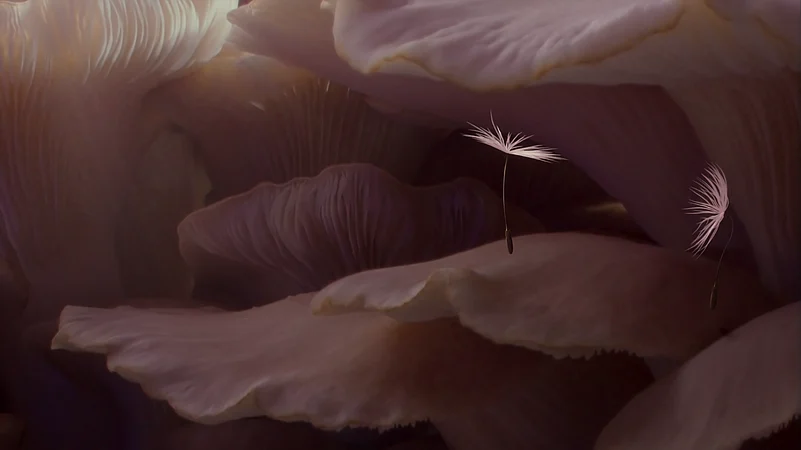“Bloom where you are planted”—a metaphor often attributed to the Genevan bishop St. Francis de Sales—was a phrase I kept returning to while watching Dandelion’s Odyssey, a 77-minute film by Momoko Seto set against the backdrop of a post-apocalyptic world. As I watched, I found myself reflecting on the challenges of blooming: What floods, burns, drowns, or plucks us as we move toward our destination—to be in full bloom? Who helps us bloom? How can one find a habitable space and convenient conditions for blooming? What lessons do we gather along the way?
The film, selected as the closing piece for Cannes Critics’ Week, depicts the infernal journey of four dandelion seeds: Dendelion, Baraban, Léonto, and Taraxa. Having escaped a burning Earth in the aftermath of nuclear war, they are cast into the cosmos. They must find a new home—a space to bloom to escape extinction. They long to place themselves as they travel through planets and constellations—as do all who find themselves displaced.

The film’s title nods directly to Homer’s Odyssey, the 8th-century BCE epic that follows Odysseus, king of Ithaca, as he navigates a decade of shipwrecks, sorcery, and divine grudges to return to his wife, Penelope, and son, Telemachus. The Odyssey tells a story of survival and stubbornness, where a hero claws his way back to the life he left behind. Over a millennium later, Dante reimagined that journey in his early 14th-century Inferno, an allegorical descent through Hell’s nine circles—less about monsters, more about moral reckoning. Dandelion’s Odyssey, too, is structured like an allegory. If the Odyssey is about returning home, and Inferno about earning it, then this film is about the desperate, fragile hope of finding one at all. Within its scope, the film becomes an allegory of displacement, resilience, and the will to root—even in the face of adversity.
Allegory isn’t the only literary device woven into the fabric of Dandelion’s Odyssey—an ecological sci-fi abundantly loaded with personification, poetic justice, metaphor, and allusion. At its heart exist four displaced dandelion achenes drifting through the cosmos that are never just seeds—they are fragile souls. Guionne Leroy, the film’s lead animator, breathes life into them, using the trembling, curling, and leaping of the parachute-like pappus to express fear, grief, and rage. In a silent film, these shudders carry the weight of displacement and the lingering anxiety of searching for a new habitat, transforming motion into raw emotion.

The topic of emotion brings me to the film’s quiet but powerful undercurrent: friendship. Having escaped their familiar world, the seeds wade through their intergalactic journey with only each other for support. They leap, skate, and glide—but always glance back to ensure no one is left behind. When separated, they return for one another. They embrace, with their pappi heads gently entwining in a silent gesture of comfort and solidarity. Dandelion’s Odyssey reminds us that in the vast unknown, it is the presence of well-meaning friends that makes the journey not just bearable, but beautiful.
Their friendship is forged in the shared grief of losing home and the ache of existing on the liminal edges of belonging. What happens when you know you can never return to the place you once called home? You enter each new space with a flicker of hope—is this it? Could this be where our roots grow? With every letdown, you fall and fail a little harder, then gather yourself again for what’s next. Each disappointment leaves the heart a little more worn, a little more tender. Still, the quest continues—even if it leads you through nine circles of hell (Inferno), or as in this film, into the vast unknown of an ecological biome waiting to be explored. Needless to say, in a journey as devastating as theirs (also, the journey of life—if we were to personify), “getting by with a little help from one’s friends” feels just about right.

Amid the chaos of the uncharted, help arrives unexpectedly, from the unlikeliest of places. Nature, almost sentient, stirs itself to aid the drifting dandelion achenes. In this film, nature plays both an adversary and an ally: it scorches, floods, and hurls them through darkness, yet cradles them just enough to keep them going. The way the seeds behold nature—with awe, humility, and caution—is perhaps how we, too, should have looked at it. But we humans have been so assured of our place at the center of creation, that we forged weapons powerful enough to scald the very ground that sustains us. Thankfully, the dandelion seeds know better.
Besides the animation and writing, the music of the film deserves special mention. In a silent film where the protagonists have no eyes, ears, or faces to express emotions, it is the movement of the achenes—paired with the music—that conveys crucial sentiments and shapes the film’s emotional landscape. Composers Quentin Sirjacq and Nicolas Becker support Seto’s powerful storytelling through an immersive sound design, often using violin and piano to heighten the tension of pivotal moments.
In Dandelion’s Odyssey, the pathos of displaced seeds becomes an inquiry into resilience, belonging, and the quiet power of friendship. Through evocative animation, an immersive soundscape, and a narrative rooted in allegory, the film invites us to reflect on our own fragile place within the vast ecosystem of existence. It reminds us that even in the face of loss and the vast unknown, we must remember to bloom—wherever we are planted—with a handful of friends beside us and a heart full of hope as our guide.
Dandelion’s Odyssey screened at the Critics’ Week at Cannes 2025.
Sritama Bhattacharyya has an M.Phil in Women’s Studies from Jadavpur University, Kolkata. She is currently an English Teacher based in Washington















